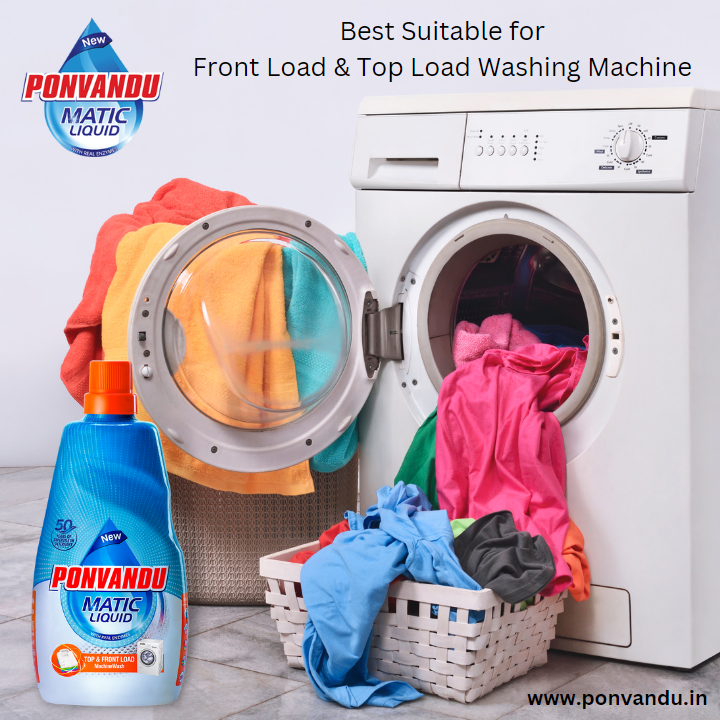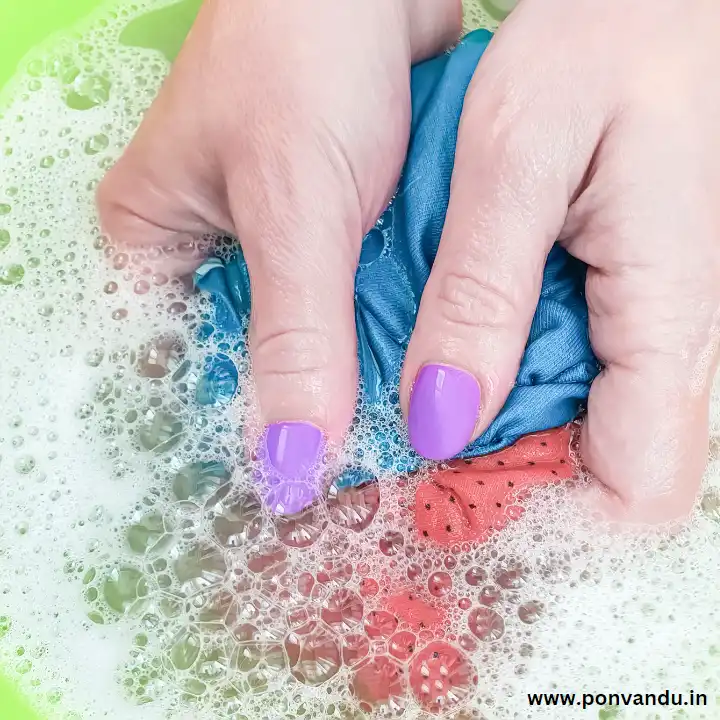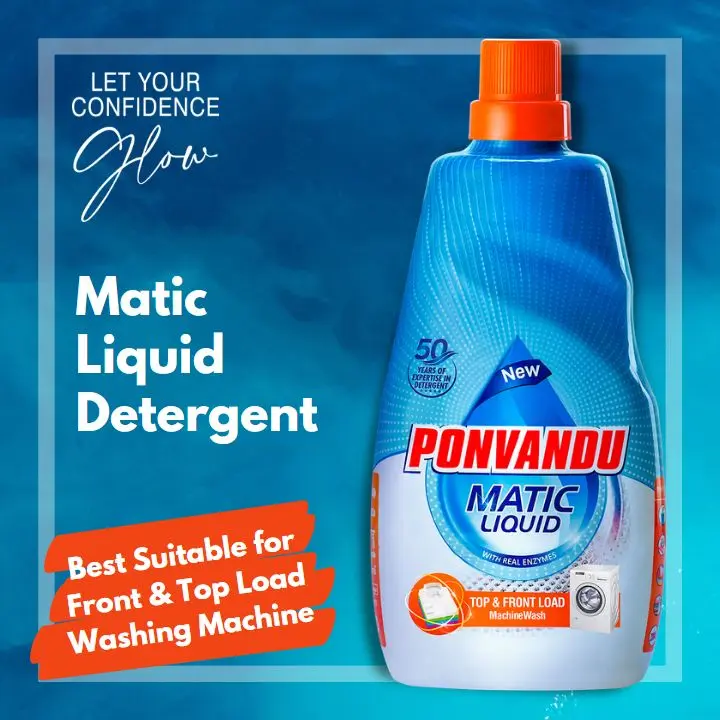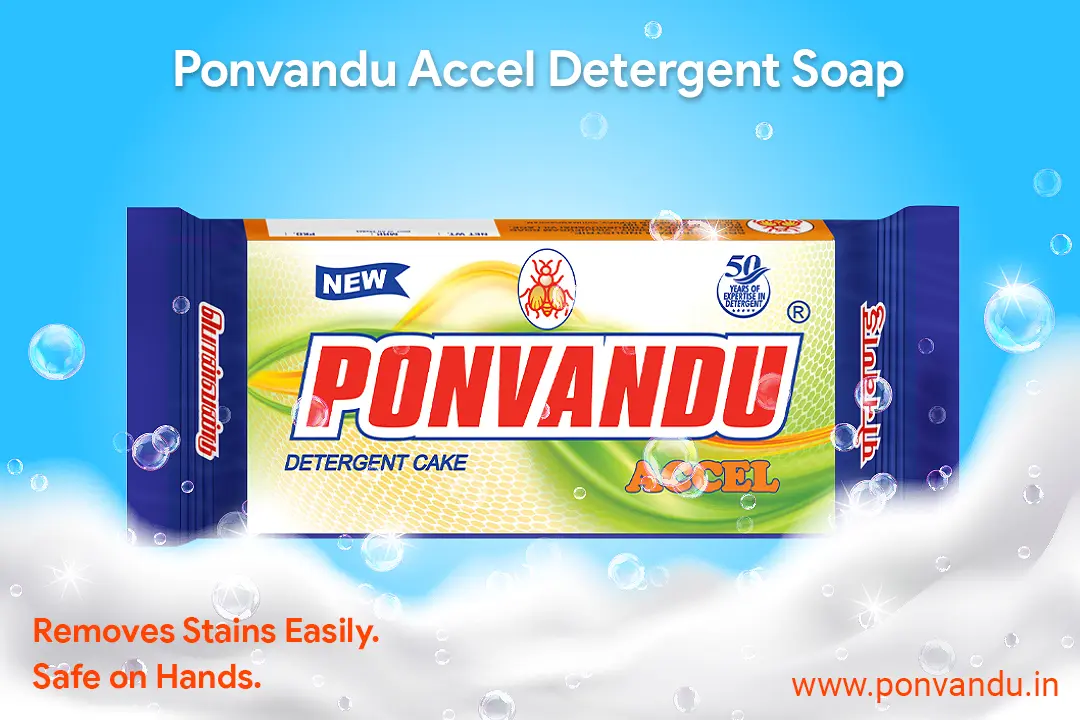Ponvandu Matic Liquid Detergent is a powerful and effective solution for all your laundry needs. Its advanced cleaning technology penetrates deep into the fabric, lifting dirt and stains from every fiber, making it tough on stains while remaining gentle on your clothes. Its unique formula is designed to protect the fabric’s color and texture, preventing fading and damage, and it is also suitable for use on delicate fabrics such as silk and wool. Additionally, it is an eco-friendly option for laundry, biodegradable, and packaged in a recyclable bottle. With its superior cleaning performance, value for money, and sustainability credentials, Ponvandu Matic Liquid Detergent is the ultimate solution for clean clothes.
Continue reading →Bleach is a straightforward, one-step solution to numerous washing issues. However, it might be bad for the environment and your health. After applying bleach, your clothes will also become sticky, smell bad, and have a yellow color.
Therefore, you should not use bleach on your clothes even though you want them to be whiter. How can you proceed?
There are many “natural alternatives” to bleach, but many people don’t use them because they don’t know what they are or don’t want to risk their clothes.
We will show you how to whiten clothes without bleach in this article, as well as some other helpful hints to keep your laundry smelling fresh and clean!

Why do white garments become yellowish?
Every wardrobe includes a crisp white shirt or a white T-shirt. On the other hand, have you noticed that they have degenerated into yellow over & over usage.? White clothes can get dirty for a lot of different reasons.

The following are a few examples:
- The colors of other textiles may shift, especially if you wash everything at the same time.
- The fabric retains detergent powder and fabric softener residue.
- Environmental factors like smoking or pollution in the air
- Oils and stains on the body are brought on by food and drink.
Clothes that can be whitened without bleach:
There are numerous home methods for whitening clothing without bleach. Allow us to show you a few extraordinary options when you are considering how to brighten garments without bleach. You will learn how to effectively whiten your clothes using a few common household ingredients after reading this article.
1. White Vinegar:
White vinegar is useful for removing dirt and stains. It is also gentle on fabrics and helps them naturally soften, so you don’t have to use chemical fabric softeners.
How to Use It
Before beginning the wash cycle, add 1/2 to 1 cup of distilled white vinegar to your Ponvandu Matic Liquid detergent.
Put a small amount of white vinegar into any stains on your clothing and let it sit for an hour before washing.
After a few minutes, wash your white clothes as usual.

2. Lemon:
Citric acid, which can bleach materials, is found in lemons. It also works to whiten linen, cotton, and polyester fibers.
How to Use It
Combine one 3.5 Litre of warm water with half a cup of the juice of four lemons. After that, add the white clothes to the lemon water and allow them to soak for at least an hour. To make garments more white, you can drench them for longer, even for the time being. After that, wash them as usual.

3. Baking Soda:
Baking soda can be easily available in the cabinet in your kitchen, but you should also put some in your laundry room. The clothes can be whitened with the help of baking soda and water.
How to Use It
In 3.5 Litre of warm water, combine one cup of baking soda. After that, add the white clothing and submerged for at least an hour, possibly all night. The sodium bicarbonate will help get rid of the dirt that makes cotton clothes look dull. After that, wash them as usual.

4. Borax Powder:
Natural mineral borax helps get rid of stains and cuts through dulling residue. Your regular laundry detergent will perform better and regain its color and cleanliness if you add a small amount of borax to it.
How to Use It
In 3.5 Litre of warm water, add half a cup of borax powder. The white clothing should be soaked for at least 30 minutes, if not longer, in this mixture. After that, wash the garments with Ponvandu Matic Liquid Detergent as usual.
5. Bluing:
Powdered and liquid versions of the traditional substance known as “bluing” are available in nearby grocery shops. Add a tiny amount of blue iron pigment, making the cloth appear white from an optical perspective.
Find the best bluing agent at your local grocery store and carefully follow the directions on the bottle.
Bluing can be used in either the rinse or wash cycles, but you should always dilute it and follow the directions carefully. It can be used again, even though it fades after a few washes.

6. Sunshine:
The sun’s ultraviolet (UV) rays can make brightly colored clothing fade, but they also make white clothes shine. UV rays kill a variety of microorganisms, helping to disinfect materials as well as bleach cloth.
Avoid using the dryer cycle when the clothes are still damp from being washed. Then, to naturally whiten them, lay them out in the sun rather than exposing them to extreme heat.
Your clothing will become whiter and last longer if you line-dry it. Therefore, allow the sun and wind to restore your clothing’s color.

How can I whiten a shirt with black and white stripes without affecting the black stripes or fading them?
Utilize the daylight, vinegar, or baking soft drink systems. When you do this, the colors won’t change. Never make use of bleach or any other chemical.
Conclusion
Whites are the most challenging color to keep looking new. Even after a short time, they begin to appear dirty. Stains caused by sweat and oils develop quickly and are more challenging to remove.
However, using bleach to whiten clothing can be harmful to both you and the clothing. You must now be wondering how to whiten clothing without bleach.
In this article, we’ve listed 6 simple ways to whiten your clothes without bleach. Using any one of these methods, white clothes can be achieved without bleach. Also, don’t be afraid to experiment with different whitening methods to see if you can come up with new ways to keep your clothes white and clean.
After treating white clothes with any of the above methods, always use Ponvandu Matic Liquid Detergent for washing your stained clothes. Ponvandu Matic Liquid best suitable for Front-load & Top load washing machines.
Buy Ponvandu Matic Online from www.bigbasket.com
Today we are going to discuss the Eight common laundry mistakes while washing clothes.
1. Sorting of clothes
Simply isolating the whites from colored garments isn’t sufficient. Not only should clothes be sorted by color, but also by size, weight, fabric, how dirty they are, and so on.
Because these factors determine the amount of soaking and detergent required. Towels, bed linen, and newly purchased clothing should all be washed separately.
It will shield your clothing from lint, odor, and color bleeding. To prevent odor, wash kitchen clothes separately.
2. Excessive Rubbing
Although it makes sense to scrub stains prior to washing, Exercise caution. Work your way inward from the outside when scrubbing. You could think it is smarter to go after the center first, however, the relaxing of the particles might make the stain spread.
The purpose of vigorous rubbing will be lost as the stain will become even more deeply ingrained. Before scrubbing, use a stain remover to loosen the particles and make them easier to remove.
3. Using Ordinary Detergent Powder
Ordinary Detergent Powder can get stuck and accumulate between the fibers, especially in woolen and other fabrics with loose weaves. The garment’s lifespan is reduced as a result. On the other hand, liquid detergents like Ponvandu Matic Liquid completely dissolve in water and won’t harm your clothes.
Additionally, it is allergy-safe and easy to rinse, making it safe for infant clothing. Stains can also be treated with Ponvandu Matic Liquid Detergent prior to washing. Because the pH factor is more equable, they are gentler than ordinary powder detergents.
4. Know which is First
Water, detergent, and clothes in the wrong order; Isn’t that what ought to be done? Not exactly. The sensors may become confused about the level of the water if clothes are put on after the water. The best method is to first place the clothes, then add water, letting the machine choose how much, and then Ponvandu Matic Liquid Detergent.
When you use a Ponvandu Matic liquid, it will completely dissolve without clumping or congealing.
5. Not reading the label
Every fabric and garment sold today comes with clear washing instructions on the label, so it’s important to read them carefully. Some clothes require more detergent while others require less scrubbing. Some prefer cold water, while others require warm water. Your clothes will last longer if you sort them and wash them in accordance with the label’s instructions.

6. Not zipping up
Before washing, it may appear prudent to zip up button-up shirts and pants. Although zipping up is a good idea, buttoning up a shirt can put pressure on the buttons and make them come off. To prevent the metal from causing damage to other clothing, any garment hooks should be fastened. You will have an easier time sorting matching pairs if you tie up pairs of socks.
7. Excessing
Anything excess is bad. It is a myth to use too much detergent, bleach, or heat in the hope that it will make your clothes clean better. In point of fact, it may harm your clothing. Excessive heat can not only cause the material to degrade and pose a fire hazard in the case of synthetic fabrics, which are frequently made from petroleum by-products. While too much bleach can harm your clothes, too little will not be effective.
8. Ignoring the lint
After each wash cycle, it is essential to empty the lint catcher and clean the mesh filter. If the lint escapes the filter, it might stain the clothes and stick to them. After some time, it will also emit an unpleasant odor, which is likely to remain on the washed clothes. Additionally, lint can clog the machine and pose a fire risk.
A little tenderness and care can go a long way. Ponvandu Matic Liquid is a liquid detergent with a pleasant fragrance scent that is gentle on your clothes. Because it has a low pH, it is gentle on clothing. It has a built-in fabric conditioner and gives washed clothes a light, pleasant scent all day*. In addition, it is entirely alright for child garments. The product has been made for both top load and front load washing machines, so it will not only get the best cleaning, but it will also make the machine work better and last longer.
Buy Ponvandu Matic Liquid from Bigbasket
Ponvandu Accel Detergent Soap
Best Selling Ponvandu Accel Detergent Soap. A brand that is taking the market by storm! With its unique blend of ingredients, Ponvandu promises to clean your clothes like never before.
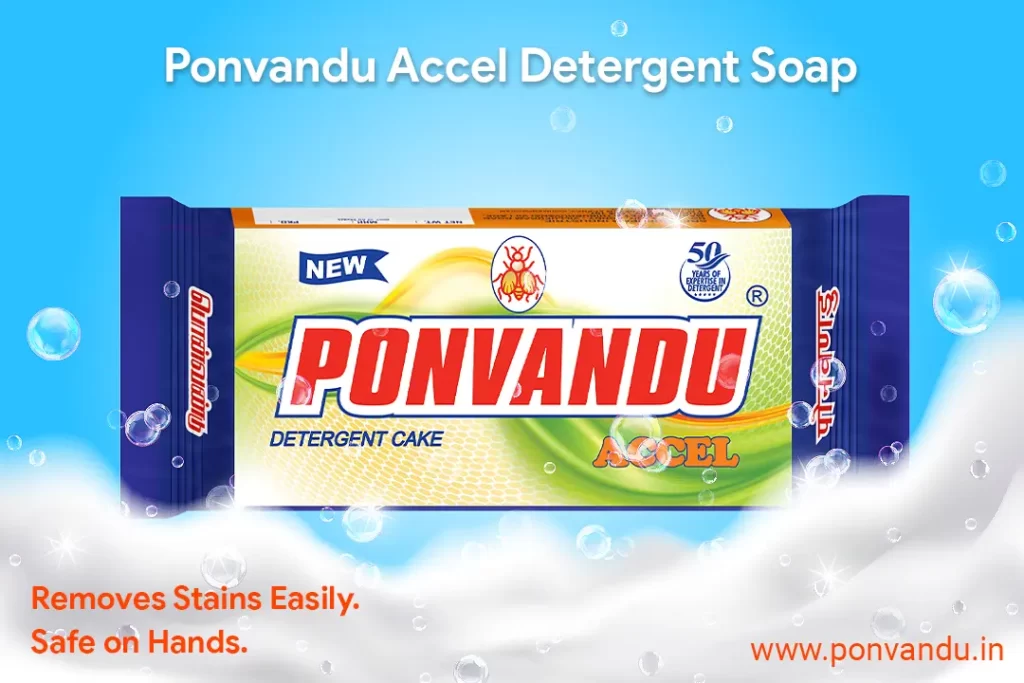
Key Benefits of Ponvandu Accel Detergent cake
One of the key features of Ponvandu is its powerful stain-fighting formula. The Accel soap is specially formulated to tackle tough stains like grease, oil, and mud, leaving your clothes spotless and smelling fresh like new always. Whether it’s a mud stain from a day of playing sports or a grease stain from a hard day’s work, Ponvandu Accel soap has got you covered with its powerful ingredients.
Ponvandu isn’t just tough on stains – it’s also gentle on your clothes. The soap is made with selective ingredients that are safe for all types of fabrics, including delicates. This means that your clothes will come out looking and feeling like new, without any of the harsh chemicals found in traditional detergents.
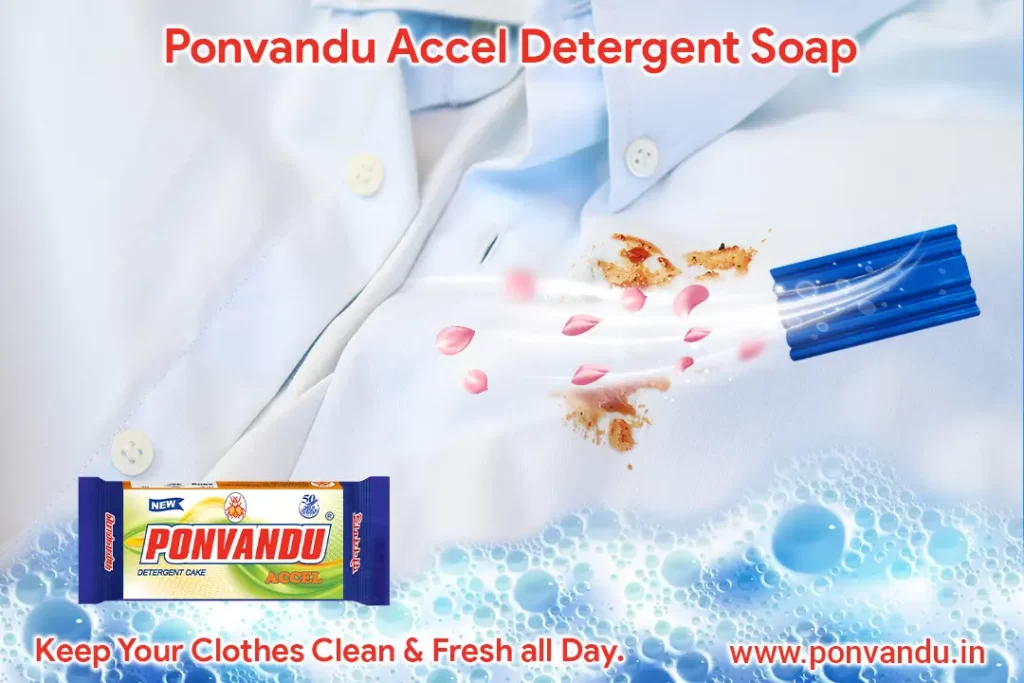
One of the best things about Ponvandu is that it is available in all the shops. So no matter how you prefer to do your laundry, Ponvandu has a form that will work for you.
Ponvandu is affordably priced and easily available in the market and also on Online platforms like BigBasket.

This makes it accessible for all types of households, whether you’re a college student living in a dorm or a family with kids.
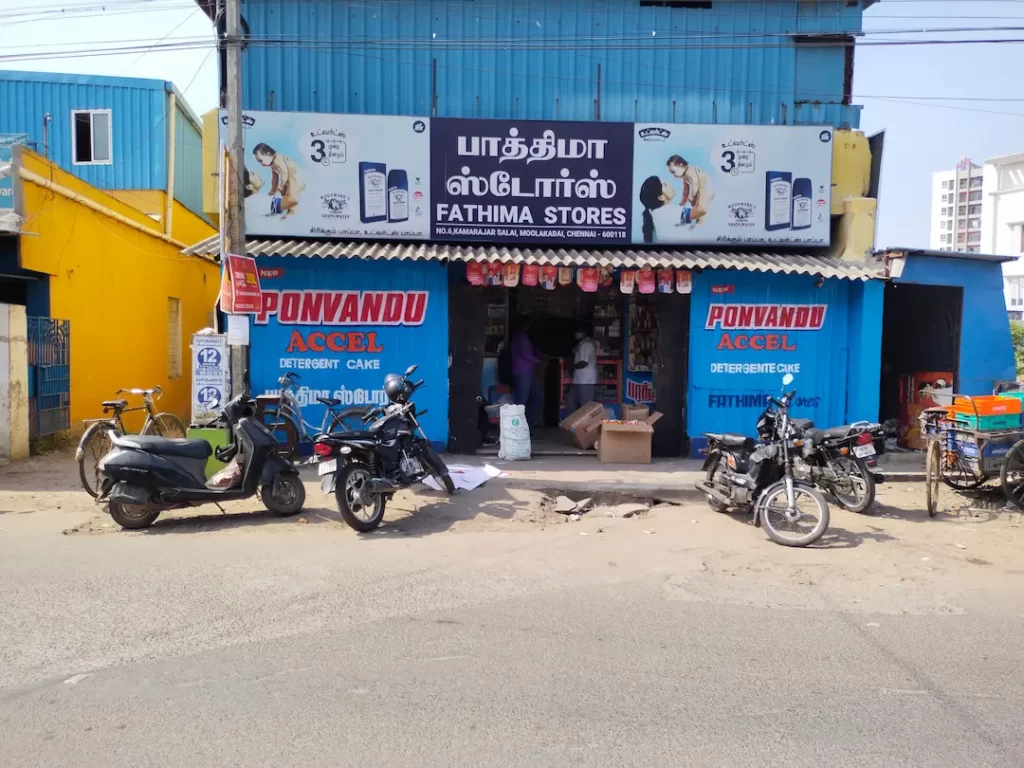
Ponvandu is a detergent soap brand that stands out from the rest. Its powerful stain-fighting formula, gentle ingredients, eco-friendly formula, different forms, and affordable price point, make it a great choice for anyone looking for a high-quality detergent soap. So give Ponvandu a try and experience the difference for yourself!
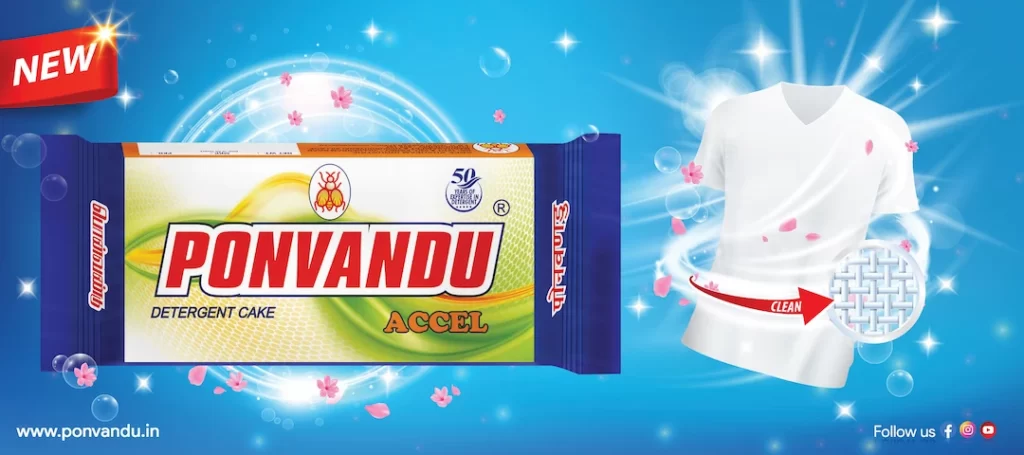
Here we are going to discuss the difference between top-load and front-load Washing Machines?
Nowadays we have a wide range of ideal washing machines for your family by learning which washing machine removes dirt the best, is less expensive, saves water, and has less time taking for clothes washing.
Even though washing clothes is probably not the highlight of your week, having a dependable and effective washing machine makes it much easier. You will need to choose between two basic types when purchasing a new washing machine or replacing an old washing machine that uses too much energy.
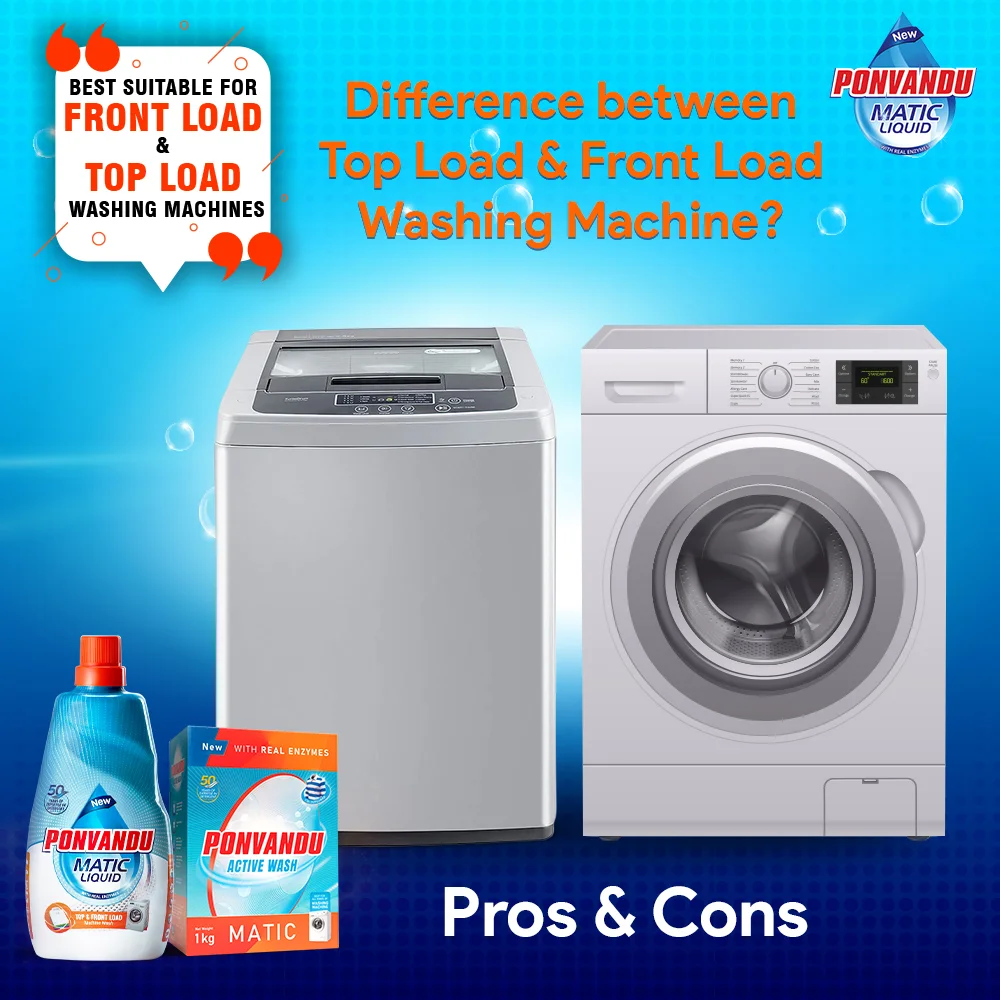
Top-load Washing Machine vs Front-loading Washing Machine.
Both washing machines remove excess moisture from dirty linens, clothes, and other washables by swishing them through soapy water first, then rinsing off the soap. Using Ponvandu Matic Liquid detergent helps to remove stains easily in the first wash. However, there are differences between the two types of washing machines, the most fundamental of which is whether the door is in front or on top.
Top load washing machine agitator vs non agitator machines.
Another significant distinction is the presence or lack of an agitator present in the center of a standard top drum. However, the agitator can be rough on clothing, resulting in wear, tear, and fading. The pounding action of the wash against the agitator helps release dirt and oils so that ponvandu matic liquid detergent can easily remove them. Instead of using agitators, front-loading washers tumble the laundry inside the rotating drum to help break up dirt and grime. The agitator has been replaced in more recent high-efficiency (HE) top-loaders with an impeller plate, and a low-profile revolving hub with vanes, which adds additional motion to the load without the fabric-pummeling effect of an agitator. The impeller plate is located at the bottom of the drum.

The majority of Indians still prefer top-loaders over agitators, despite the fact that the majority of Top brand washer manufacturers offer both front-load and top-load models. Top loaders made up 76% of all washing machines sold in 2015, with 52% of those machines being HE models, according to a survey conducted by the Association of Home Appliance Manufacturers. However, the front-loader market continues to expand. Continue reading for head-to-head comparisons of top-load vs. front-load washers so that you can fully comprehend the benefits and drawbacks of each and ultimately decide which option is best for your home.
Performance is improved by front-loaders
In almost every consumer-group study, front-loaders perform better than top-loaders when it comes to fresh, clean laundry. The tumbling-through-air-and-water motion of a front-loader allows the water and detergent to effectively penetrate the fabric, removing stains, odors, oils, and other grime more effectively than the back-and-forth agitation of a top-loader, provided that you do not overstuff the unit. Additionally, front-loaders are gentler on your washables.
Larger loads are handled by front-loaders
Full-size front-loaders typically have larger capacities than full-size top-loaders, despite the fact that washing machines of both types are available in a variety of capacities, including compact models designed for small living spaces. The drum capacity of the typical front loader ranges from four to five cubic feet, while the capacity of the typical top-load machine with an agitator ranges from three to four cubic feet. The majority of HE top-loaders fall somewhere in the middle. To put that into perspective, to wash a queen-size comforter, you need about four cubic feet. But before you buy the biggest machine, make sure it will fit in your laundry room. The bigger the capacity, the bigger the machine will be.
Ergonomically, Top-Loaders are Better
A Top loader is generally more comfortable to use because you can stand straight up in front of it, whereas a Front loader requires you to bend to reach inside. If you want a front-load washer but are worried about hurting your back, a pedestal can give you more comfort. These raisers for the washer and dryer that go under them raise them by 12 to 16 inches. For an additional few hundred dollars, this option is offered by every front-load machine manufacturer, and most pedestals include a handy drawer for laundry supplies. You will need to purchase pedestals that are sized to fit your washer and dryer models; this is a common add-on when purchasing these appliances for the laundry room.

Overall, Top-loaders save money.
Even though front-loaders and HE top-loaders use less energy to run, they cost less to run. However, you’ll pay a lot more upfront for either of these machines than you would for a traditional top-loader, often by several thousand rupees. Additionally, there is a greater risk of malfunction when a model features a greater number of high-tech electronic components.
A front loader typically comes with higher upkeep costs as well. The development of mold and black slime around the door’s rubber gasket is a common problem with these machines. This can be avoided by cleaning the gasket on a regular basis and leaving the door open after each use to allow the machine to dry out between uses.
However, in the event that an issue creates you might have to supplant the gasket. Because the suspension that is supporting the drum of the front loader is more likely to fail as a result of the strain, overloading the front loader is also more likely to result in a visit from the repairman than overloading the top loader.
In terms of lifespan, a top loader is most likely to last ten years or more, while a front loader is less likely to last that long, given equal use and upkeep. It’s a draw when it comes to noise and vibration.
Here is the best detergent liquid to get the best results for washing your stained clothes for both top load and front load washing machine was likely the Ponvandu matic liquid detergent.
Top loaders can be noisy, but they rarely vibrate much during any cycle unless the load becomes unbalanced. On the other hand, front-load machines only make a whirring sound but can transmit powerful vibrations to non-concrete floors, like vinyl or wood, because their drums spin so quickly.
Even though more recent front loaders are less likely to vibrate, you should still take this into account if your laundry room is upstairs or has wood floors.
A top loader will cut down on time significantly
Don’t buy a front loader if you need to finish your laundry quickly because it can take twice as long to complete a wash cycle. This is due to the fact that top-loaders only fill with water once during a cycle, whereas front-loaders have a more complex wash cycle that involves water entering the drum and draining several times.
There are now time-saving settings available for some front-loaders, but because less water is exposed, your clothes may not come out as clean when you use them quickly.
Less water is used by front-loaders
Reduced water consumption is one of the front-load washers’ greatest advantages. It is a significant distinction: To wash and rinse laundry, a typical top-loader requires 30 to 40 gallons of water, whereas a typical front-loader only requires 10 to 15 gallons for the same tasks. The HE top-loaders fall somewhere in between; Each load typically calls for 15 to 20 gallons of water. Not only will using less water result in a lower water bill, but it will also require less energy to heat the water during a warm or hot water wash cycle.
Laundry Rooms Front-loaders utilize space effectively. Stacking a set of front-load washer and dryer appliances is possible with a stacking bracket. This indicates that full-size machines can still be used in confined spaces. Don’t forget to include a comfortable swing room when measuring your available space because you’ll need room to open the doors.
Although “laundry towers” that come pre-stacked and have a top-load washer on the bottom are available, these units are small and are typically used in apartments or other living spaces with limited space.
Using a good quality Liquid Detergent is very crucial to keep the machine last longer.
Taking this issue seriously Ponvandu Matic Liquid Detergent helps washing machine users remove the stains from their clothes easily in one quick wash. Thus the life of your washing machine extends without any question.
Every month, your Washing machine needs to be thoroughly cleaned, and we’ll show you exactly how to do it with natural and chemical cleaners.
Even though cleaning your Front-load washing machine & Top Load washing machine on a regular basis especially when it comes to your washing machine may seem counterintuitive, it is still essential. How frequently should this workhouse’s laundry room be cleaned? Your washing machine should be cleaned about once a month.

Cleaning your washing machine
How to clean your washing machine? Cleaning your washing machine should be seen more as a preventative measure than something you do to fix a problem once it occurs.” It’s time to clean your washing machine if you start to notice that your clothes don’t smell as clean as they should.
You might also observe the accumulation of various types of debris, such as tiny mud or sand, pet fur, and leaves. Around the seals, that indicates that you might not have run a complete cleaning cycle in a while. In addition to debris, the minerals in your water and detergent residue from your detergent and bath products can accumulate and provide room for the growth of bacteria over time.
Not only could this residue eventually clog up your machine’s internal mechanisms, but it could also affect how it works. This could indicate a change in the water’s temperature or a transfer of odors between clothing.
In the following section, we’ll show you how to clean your washing machine with chemical and natural methods (including using vinegar!).
How to Get Started Cleaning Your Washing Machine to get started, use an all-purpose cleaner to clean the machine’s interior and the seals around the door. Hartford explains that any filters or drains around the seal should be cleared of debris for top-loading machines. If you have a front-loading washer, locate the drain filter and shake it over the trash. It should be behind a small front-facing door near the bottom. Before replacing it, thoroughly rinse it.
When you take the cap off the drain tube, make sure you have a big bowl on hand so you can catch any extra water that falls out.
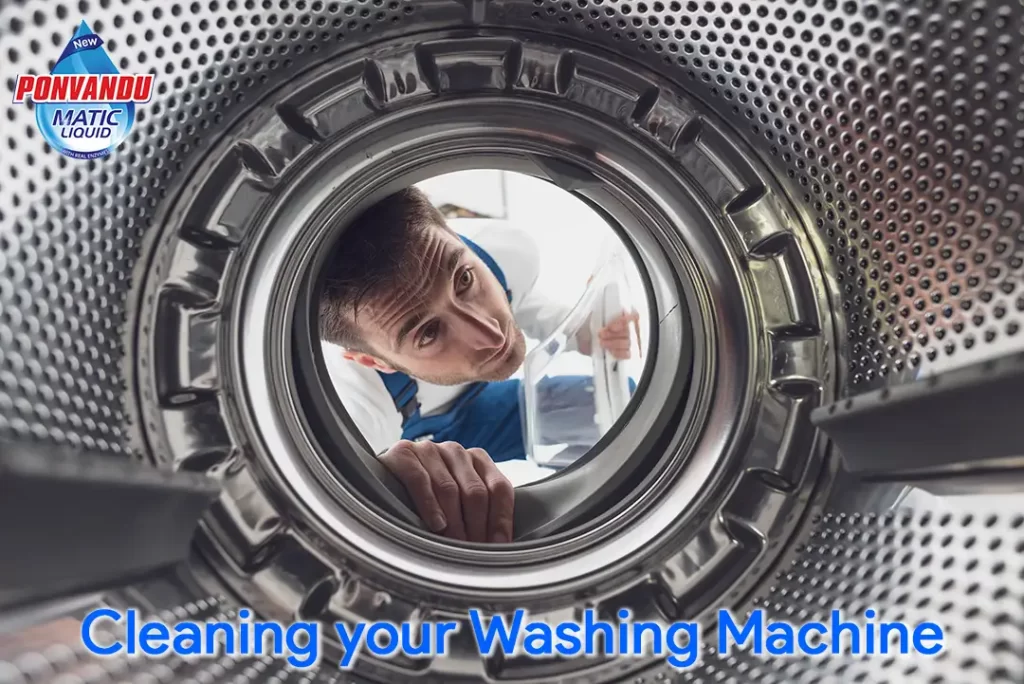
How to Clean Your Washing Machine with Vinegar
Hartford suggests using a washing machine cleaner, if you’re experiencing unpleasant odors in your machine or when you wash your clothes. simply adhere to the package’s directions.
However, if you don’t want to use a chemical formula, there is another way to clean and eliminate odors from your washing machine, and you probably already have the solution under your kitchen sink: acetic acid. “Especially when combined with baking soda, the acidity kills bacteria, cuts through grime and buildup, and eliminates odors,”
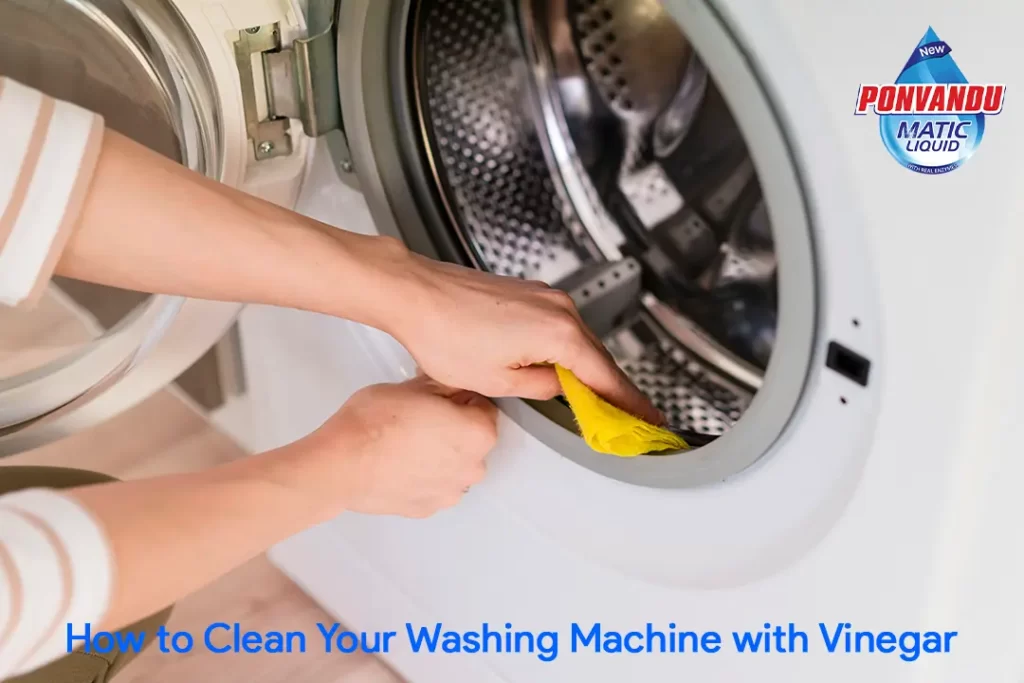
Before undertaking this DIY, We recommend checking the owner’s manual for your washer. Put two cups of vinegar into your detergent dispenser and run your washer on the hot cycle if all is well. At the point when it is finished, add a half-cup of baking soda to the drum and run another hot cycle.
After this cycle, wipe down the drum with a microfiber towel before sealing the door by spraying the interior with more vinegar (add some to a clean spray bottle to make the process easier). “The vinegar and hot water together are enough to wash away a small amount of soap residue buildup.
The problem is this: Because they use more water per wash, you’ll need to add more vinegar to the cycle if you’re using a non-high-efficiency (HE) machine.
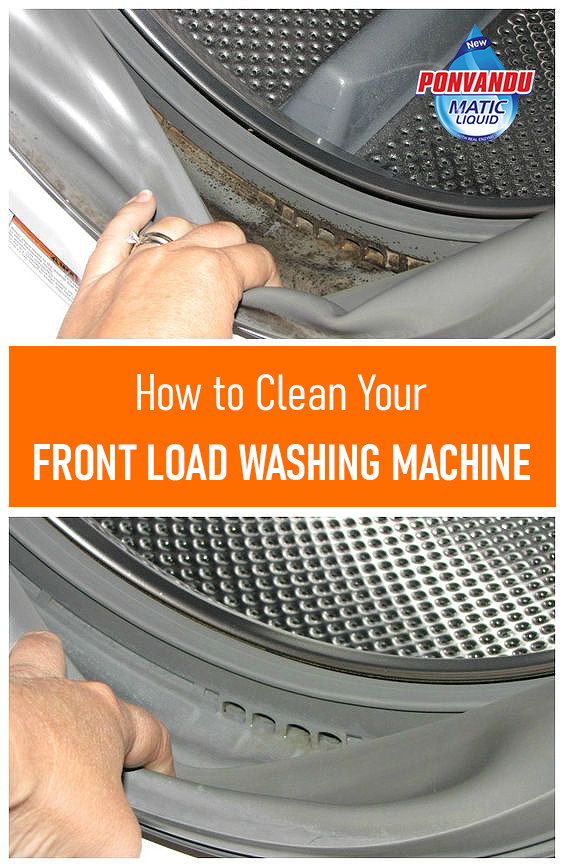
Always use Ponvandu Matic Liquid Detergent for washing stained clothes. Our Ponvandu Liquid Detergent is very well suitable for both Front-load washing machines & top-load washing machines. The liquid detergent even works well with Semi-Automatic machines also.





